The Chilean fire rose is a ground-dwelling spider, because it is a variant variety of the Chilean red rose spider, so the two look very similar, so it is necessary for us to Understand the morphological characteristics of the Chilean fire rose to distinguish the two. In order to better raise the Chilean fire rose, we should also understand its living environment!

Chile fire rose spider
Chile fire rosemorphological characteristics
The juvenile Chilean fire rose is very similar to the red rose spider, and it is difficult for a professional to tell the difference. The easiest way to tell them apart is to look at the color of their backs. Learn more about the basic characteristics of Chilean roses below. Chile fire roses differ from Chilean red roses mainly in that they look redder. Adults are about 14-15 cm long and the carapace is red rather than pink. However, they are less common than Chilean red roses. They were once considered to be red varieties of Chilean red roses, and shared the Latin scientific name Grammostola rosea with Chilean red roses, but now European and American enthusiasts use Grammostola porteri to call Chilean red roses, and recognize them as two types of red roses. exist as an independent species.
Chile fire roses are noticeably more reddish when they are more than 6 cm above their adult color, while Chilean red roses are more grayish-white. Mating a female Chilean red rose with a male Chilean fire rose and successfully produced some offspring. The high hatchability of eggs (almost 100%) also shows that even if they are two species, they are very, very closely related.
Chile Fire Rose Living Environment
Chile Fire Rose is a ground-dwelling spider and is good at making ground webs. Because of its attractive appearance, many people buy and raise it. Chilean fire roses like to inhabit grasslands or rain forests in the wild. If domesticated, it is recommended to arrange the breeding environment according to their living habits in the wild.
The bedding material in the breeding box of Chilean fire roses can be mixed with coconut bricks and peat. A water glass and a shelter are indispensable. If raising larvae, there is no need to add a water cup or put cotton in the water cup. To prevent the larvae from falling into the water and dying. They are suitable for survival in an environment of 25-27°C, and the humidity can be controlled at 60-70%.

Subscribe to Newsletter
Professional platform for pets, dogs and cats.
![[Dog Training 5] The training method of pet dog dining etiquette](/static/img/12192/12192_1.jpg)




